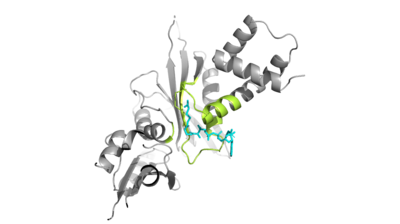User:Caitlin Marie Gaich/Sandbox1
From Proteopedia
(Difference between revisions)
| Line 7: | Line 7: | ||
== Introduction == | == Introduction == | ||
[https://en.wikipedia.org/wiki/Histone Histones]are the key building blocks of [https://en.wikipedia.org/wiki/Chromatin chromatin]. They are subject to post-translational modifications and play important roles in replication, transcription, heterochromatin maintenance, and DNA repair. Histone acetylation is a common histone modification. This involves the transfer of an acetyl moiety from Acetyl Coenzyme A (AcCoA) to an ε-amino group of the target lysine residue on a histone. This reaction is catalyzed by the histone acetyltransferase (HAT) enzyme families. The specific histone acetylation modification is an important [https://en.wikipedia.org/wiki/Epigenetics epigenetic] marker. It plays a role in RNA synthesis and there a known correlation between gene activity and histone acetylation. Any misregulations of the HAT enzyme can possibly lead to cancer, cardiovascular disease, and HIV. | [https://en.wikipedia.org/wiki/Histone Histones]are the key building blocks of [https://en.wikipedia.org/wiki/Chromatin chromatin]. They are subject to post-translational modifications and play important roles in replication, transcription, heterochromatin maintenance, and DNA repair. Histone acetylation is a common histone modification. This involves the transfer of an acetyl moiety from Acetyl Coenzyme A (AcCoA) to an ε-amino group of the target lysine residue on a histone. This reaction is catalyzed by the histone acetyltransferase (HAT) enzyme families. The specific histone acetylation modification is an important [https://en.wikipedia.org/wiki/Epigenetics epigenetic] marker. It plays a role in RNA synthesis and there a known correlation between gene activity and histone acetylation. Any misregulations of the HAT enzyme can possibly lead to cancer, cardiovascular disease, and HIV. | ||
| + | |||
== HAT1 Background == | == HAT1 Background == | ||
[[Image:Main_bonding_cartoon_3.png|400px|right|thumb|Figure 1]] | [[Image:Main_bonding_cartoon_3.png|400px|right|thumb|Figure 1]] | ||
| + | <scene name='81/811717/Hat1_with_accoa/1'>HAT1</scene> was the first of the HAT enzymes to be identified in yeast. It is lysine specific for newly synthesized histone 4 (H4). One study showed that the deletion of the HAT caused a loss of acetylation on H4K5 and H4K12, leading to the conclusion that HAT1 is the sole enzyme responsible for the evolutionary conserved histone modification. The HAT2 enzyme is identified as a binding partner for HAT1 to help modulate the substrate specificity of HAT1. The complex is highly specific for H4K12. | ||
== Hat1/Hat2 Complex Structure == | == Hat1/Hat2 Complex Structure == | ||
Revision as of 18:53, 11 April 2019
Histone Acetyltransferase HAT1/HAT2 Complex, Saccharomyces cerevisiae
| |||||||||||

